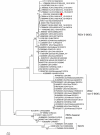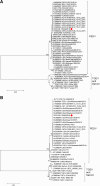The emergence of porcine epidemic diarrhoea in Croatia: molecular characterization and serology
- PMID: 31319854
- PMCID: PMC6637520
- DOI: 10.1186/s12917-019-2002-x
The emergence of porcine epidemic diarrhoea in Croatia: molecular characterization and serology
Abstract
Background: Porcine epidemic diarrhoea (PED) is an emergent/re-emergent viral pig disease (caused by the virus belonging to the Coronaviridae family, in specific the Alphacoronavirus genus) of global importance. Clinical presentation is characterized with acute diarrhoea, vomiting and dehydration in pigs of all ages, with a possible high mortality in suckling piglets. The disease emerged in the USA in 2013 causing heavy losses, and re-emerged in Europe in 2014, but with milder consequences.
Results: In the spring 2016, PED-like symptoms were reported to be seen on an agricultural holding in Eastern Croatia; laboratory workup confirmed the Croatia's first PED outbreak ever. Porcine epidemic diarrhoea virus (PEDV) strain responsible for the outbreak was of the S-INDEL genotype, much the same as other European PEDV strains. In 2017, a post-outbreak serology was carried out in three counties in Eastern Croatia, revealing seropositivity in pigs bred on four large industrial holdings (9.09%). The seroprevalence across PEDV-positive holdings was up to 82.8%. The latter holdings were unanimously managed by an enterprise that had never reported PED before.
Conclusions: PED has emerged in Croatian pig population causing potentially considerable losses. The circulating strain was of the S-INDEL genotype. Serological workup proved PEDV spread to another four agricultural holdings, demonstrating the importance of not only external, but also internal biosecurity measures.
Keywords: Croatia; Domestic pig; ELISA; Outbreak; Porcine epidemic diarrhoea virus; S-INDEL.
Conflict of interest statement
The authors declare that they have no competing interests.
Figures



References
-
- Oldham J. Letter to the editor. Pig Farming. 1972;10:72–73.
MeSH terms
Grants and funding
LinkOut - more resources
Full Text Sources

